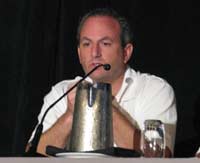Indications, results using arthroplasty or ORIF for distal humerus fractures differ
Postop complications with these techniques may include stiffness, hardware failure or nerve paresis.

Surgeons can often determine whether a distal humeral fracture is amenable to treatment with open reduction internal fixation or arthroplasty based on its AO classification, whether it is far distal or intra-articular, or if it involves one or two columns.
Regardless of the treatment used, “You want to get the patient back to function with their arm at a functional arc of at least 30° to 130° flexion/extension and 100° pronation/supination,â€� William N. Levine, MD, of New York, said in a presentation at Orthopedics Today Hawaii 2008.
He also recommended considering other factors when determining whether open reduction internal fixation (ORIF), total elbow arthroplasty (TEA) or hemiarthroplasty will produce the most reliable outcomes for a particular patient: age, activity level, desired postop range of motion and findings from the physical examination and imaging studies.
|
Image: Beadling L, Orthopedics Today |
Focus on function
Levine reviewed pros and cons of the classic treatments and newer options, like precontoured ORIF plates and the Latitude elbow prosthesis (Tornier) — which can be used as either a hemiarthroplasty or total elbow arthroplasty.
With ORIF, the goal is restoring overall arm function. “For standard bi-column fractures that aren’t terribly low [or] comminuted, the bi-plating technique or 90°-90° fixation is usually our treatment of choice,â€� where two plates bent at 90° angles are each used to fix a fractured distal humeral column, Levine said.
Patient age is important to the outcome, as well as hand dominance, if it was from high- or low-energy trauma, patient activity level, skin integrity and whether there were associated injuries.
“In most of these operations, we’re going to have to do an associated ulnar nerve transposition,� he said.
Imaging
Plain radiographs and computed tomography (CT) scans aid in surgical planning. Levine recommended using anteroposterior and oblique plain films, but said CT scans are standard at his practice because they are easy to take and provide useful information about more-complex distal humeral fractures.
“That may change your surgical technique and surgical exposure plan,� Levine said, adding that MRIs are typically unnecessary if three-dimensional CT scans are used.
When dealing with medial or lateral single-column fractures, he said the goal is to restore the articular surface of the humerus and then restore the column to the rest of the humeral shaft. Using an olecranon osteotomy to do that is controversial.
“For the very comminuted intra-articular fractures, I would propose that an olecranon osteotomy is a much better way to make sure you can get as close to an anatomic reduction as possible,� Levine said.
|
|
|
Images: Levine WN |
Pre-contoured plates
ORIF involves surgeon-contoured plates that fit around the epicondyle, restoring the spool and articular surface, coupled with 90°-90° plates for column restoration. Pre-contoured epicondylar plates are now commercially available, which make it easier to get one that fits anatomically on a consistent basis and obtain better fixation.
“Stiffness is probably the biggest concern,� along with hardware failure, frank ulnar nerve paresis, malunion or nonunion, Levine said.
Elbow arthroplasty indications also vary. It is usually suited for patients older than 65 years, with highly comminuted fractures or osteoporotic bone.
Elbow arthroplasty
The advantage of TEA is it quickly produces a satisfactory functional outcome without having to wait weeks after ORIF to determine if healing was adequate or a revision is needed for nonunion or another problem.
According to Levine, the results of total elbow replacement reported by Drs. Bernard Morrey, Mark Frankle and others are generally good, with acceptable pain relief and functional outcome, and generally low complication rates.
However, “Patients … have a permanent weight-lifting and weight-bearing restriction of no greater than 5 lbs., so you have to counsel your patients preoperatively,� he noted.
Polyethylene and bushings wear is another long-term concern.
Levine said a newer elbow hemiarthroplasty implant, the Latitude prosthesis, which maintains the native ligaments, may offer another option for treating these fractures after surgeons compile a longer track record with it. The disadvantage is it is complicated to implant and requires soft tissue balancing.
“You can certainly make an argument that a semi-linked total elbow would lead to a more predictable outcome,� he said.
|
|
|
For more information:
- William N. Levine, MD, can be reached at Columbia University Medical Center, 622 W. 168th St., PH-1117, New York, NY 10032; 212-305-0762; email: wnl1@columbia.edu. He has no financial interest in any products or companies mentioned in this article.
Reference:
- Levine WN. Distal humerus fractures: ORIF vs. elbow arthroplasty. Presented at Orthopedics Today Hawaii 2008. Jan. 13-16, 2008. Lahaina, Hawaii.






